A Modified Technique for Laparoscopic Assisted Vaginal Hysterectomy
Vaginal hysterectomy can be the standard procedure for removing the uterus, but surgical skills and indications to vaginal surgery are variable. Laparoscopic assistance to vaginal hysterectomy is a way to change the approach to hysterectomy. In this paper we describe our retroperitoneal technique for laparoscopic securing of the uterine pedicles.
Abstract
Introduction: Vaginal hysterectomy can be the standard procedure for removing the uterus, but surgical skills and indications to vaginal surgery are variable. Laparoscopic assistance to vaginal hysterectomy is a way to change the approach to hysterectomy. In this paper we describe our retroperitoneal technique for laparoscopic securing of the uterine pedicles.
Materials and methods: 24 patients with uteri above 500 gr, who would have been candidats for abdominal hysterectomy, underwent laparoscopic assisted vaginal hysterectomy. The charts of the procedures performed at the Department of Ginecologic Oncology from May 1999 to May 2001were retrospectively reviewed.
Technique: The retroperitoneum was accessed through the lateral leaf of the broad ligament and the ureter isolated at the pelvic brim. The ureter and the internal iliac artery were then dissected to the origin of the uterine artery, delimiting the pararectal fossa. At this point, the uterine artery was coagulated, previous checking of the ureter. Only at this step the infundibulo-pelvic ligaments or the utero-ovarian ligaments were severed. Section of the uterosacral ligaments, preparation of the bladder flap and opening of the vagina were performed according to the difficulty of the vaginal procedure.
Results: 23 out of 24 laparoscopic assisted vaginal hysterectomies were carried out (95.8%). One patient had laparotomy. The median weight of the uteri was 650 gr (range 500-1100). The median time for the procedure was 100 minutes (range 80-180). We did not observe postoperative complications.
Discussion: Few authors have described the retroperitoneal approach as the standard technique for laparoscopic securing of the uterine pedicles. The advantages of this approach to laparoscopically assisted vaginal hysterectomy are discussed.
Introduction
Vaginal hysterectomy (VH) can be the standard procedure for removing the uterus in most patients (Darai et al,2001; Harris and Olive, 1992; Magos et al,1996; Richardson et al,1995). However, the surgeon's individual skills and capabilities in vaginal surgery vary widely and indications or contraindications to VH are not unequivocal. Although an uterus larger than 13 weeks of pregnancy can be vaginally removed, the procedure may be difficult and sometimes challenging. Many different techniques for laparoscopic assistance to VH have been described (Aubard et al,1996; Ferrari et al,2000; Hur et al,1995; Nezhat et al,1992; Redwine, 1995; Reich et al,1989; Shwayder,1999; Summitt et al,1998) and classifications for laparoscopic assisted vaginal hysterectomy (LAVH) have been proposed (Mage et al,1995; Munro and Parker,1993). Most of these papers do not describe or take in account a modified retroperitoneal procedure with isolation of the ureter and uterine artery which allows total control of the operative field. Only Kadar (1995) describes in details the retroperitoneal hysterectomy and Schneider (1997) cites this technique for the large uterus In this paper, we describe our experience and technique for retroperitoneal dissection of the ureter and the uterine pedicles during the laparoscopic assistance to VH in cases of uterus above 500 gr.
Materials and Methods
We retrospectively considered 24 patients undergoing LAVH at our Department between May 1999 and May 2001. The procedures have been performed by two different surgeons from the same Department in two different hospitals.
The median age of the patients was 46 years (range 39-55). The median body mass index of the patients was 25.11 (range 22.31-29.72).
Two patients were nulliparous. No patient had prolapse or urinary incontinence needing treatment.
All the considered patients had an uterus above 500 gr and would be scheduled for laparotomic hysterectomy in our Department. In all patients the indication to hysterectomy was single or multiple myomas.
Prophylactic antibiotic treatment was started at the beginning of the procedure.
Technique
Our technique is based on thorough visualization of the ureteral course and on bipolar coagulation. Very few reusable instruments are used and only disposable scissors are present on the operating table.
The patient is placed in lithotomic position. The range of movements and position of the patient's legs are tested before anaesthesia is induced. No uterine manipulator is placed and only the operator and an assistant start the laparoscopic part of the procedure. Three ancillary 5 mm trocars are placed. In no case they were moved upwards even in the biggest uteri.
Once the pneumoperitoneum is induced, severing the round ligament is optional as a first step, but it can be useful for the mobilization of the uterus.
Then the anterior leaf of the broad ligament is opened parallel to the infundibulo-pelvic ligament up above the crossing with the external iliac artery.
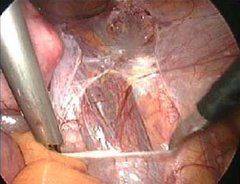

The opening must be larger than in open surgery because more space is needed. At this level, the ureter is easy to visualize by blunt dissection and the pararectal space is opened (video 1).
(Download QuickTime here to view the videos.)
The limits of the pararectal space are the ureter medially, the internal iliac artery laterally and by the uterine artery anteriorly. The hypogastric artery and the ureter are dissected out so that the uterine artery is isolated nearly at the crossing with the ureter.
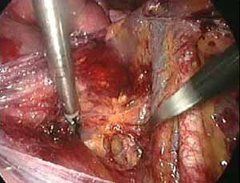

At this point, the uterine artery is completely visualized and it is coagulated at its origin from the internal iliac artery (video 2).
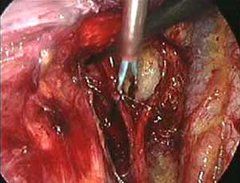

Two technical tricks are important for the completion of the procedure. First of all, the medial leaf of the broad ligament must not be opened and has to be kept intact to allow a better visualisation of the ureter which adheres to it, limiting the pararectal fossa. The medial leaf prevents the bowel from descending into this space. Secondarily, the dissection of the uterine artery has to be stared posteriorly: in fact, reaching the uterine artery starting posteriorly and following the ureter is much easier, because the dissection is directed towards the artery medially. When the dissection is performed from the paravescical space it is much easier to go laterally back to the bifurcation of the iliac vessels. The uterine artery must then be isolated and reached medially.
Once isolated, the uterine vessels are coagulated with bipolar current while the ureteral course is checked. Generally the uterine artery is not resected but only coagulated in order to avoid the bleeding. With experience it is also easy to isolate the uterine veins and coagulate them (video 3).


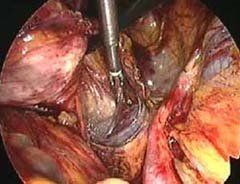
Only in difficult cases (i.e. infraligamentous myomas) and in the necessity for space anteriorly, the uterine artery is severed.
Only at this step the utero-ovarian ligament or the infundibulo-pelvic ligament are resected according to the scheduled procedure. No modification of the previous steps are needed if removal of the ovaries is required.
Further steps, such as opening of the bladder flap, severing the uterosacral ligaments, opening the vagina posteriorly are performed according to the foreseen difficulty of the vaginal part of the procedure. Vaginal morcellation of the uterus is always started with cervical amputation and later, bivalving, coring and wedge resection are performed in all cases.
No peritoneal closure is used since laparoscopic coagulation is easier (video 4).
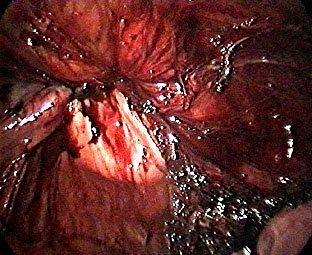
Results
Out of 24 patients, LAVH was carried out in 23 (95.8%). One of the patients had laparotomic conversion for bleeding from the infundibulopelvic ligament which retracted during coagulation. Even in this case the patient had had bilateral coagulation of the uterine arteries. The median weight of the uterus was 650 gr (range 500-1100). The median length of the procedure (from the beginning of the pneumoperitoneum to the last stitch on the skin) was 100 minutes (range 80-180). In all patients a vaginal morcellation was performed. The median time for the vaginal part of the procedure was 45 minutes (range 30-85). Morcellation can take a long part of the vaginal procedure going up to 50 minutes.
We did not observe any complication during surgery, either ureteral, bladder or intestinal lesions.
Even in the case of laparotomy transfusion was avoided.
No secondary bleeding was observed.
All patients were released within the fourth day. The median hospital stay was 3 days (range 1-4).
Discussion
Few authors have reported about the retroperitoneal approach to hysterectomy for fibroids (Kadar, 1995; Schneider et al, 1997). Schneider et al (1997) do not describe this similar approach as the standard technique for LAVH, while Kadar (1995) states that this approach is easier with the smaller uteri, while we think that bleeding control is much more important in larger uteri. Furthermore, in his description he opens the paravescical space, which is not needed with our technique.
Several ureteral injuries have been reported after LH or LAVH (Hulka et al, 1997; Hurcabie and Bruhat, 1993; Schwartz,1993; Woodland,1992). These lesions were firstly attributed to the ligation of the uterine artery, mostly by Endo-GIA (Hurcabie and Bruhat, 1993), but also by bipolar coagulation. The technique of opening the pararectal space allows to separate the ureter from the uterine artery so that coagulation is accomplished safely under direct visual control. The distance between the coagulated area and the ureter accounts for about 3-4 cm.
Coagulating the uterine artery at its origin is also important since the descending branch of the artery is also secure so that the vaginal part and morcellation can be safely carried out with minimal bleeding.
Exposure of the internal iliac artery and of the retroperitoneum is important for the laparoscopic check after the vaginal part of the procedure and it is also safer in case of a new procedure for secondary bleeding.
In our experience when the uterus is large, the ascending branch of the uterine artery is difficult to visualise because of the vertical course near the uterus. The uterine artery at its origin, is instead horizontal with respect to the laparoscopic vision and so it is always located.
This technique can be performed when most surgeons would prefer laparotomy for hysterectomy. Skilled vaginal surgeons can remove large uteri vaginally (Darai et al,2001; Magos et al,1996; Richardson et al,1995), but the laparoscopic retroperitoneal approach can offer the advantage of identification and dissection of the ureter even in difficult cases. Furthermore, LAVH could really be considered a substitute of abdominal hysterectomy in situations in which vaginal hysterectomy is performed with indications different from myomas or pelvic prolapse ( endometrial hyperplasia, adnexal pathology…).
We never use a uterine manipulator since the uterus, when elevated, can occupy the field of view. The uterus is moved laterally so that the side wall dissection can be carried out.
It is true that the time involved in the procedure is longer than in vaginal or laparotomic hysterectomy. However, this approach can avoid some longitudinal scars in young women and the postoperative course is similar, if not better, to vaginal hysterectomy. Our experience was obtained in two different hospitals by the same operators. In one, the patients were released on the first postoperative day, while in the second the patients generally went home on the third day. This is due to a different attitude towards the release of the patients in the two hospitals. No bleeding complication was observed in the first group. We believe that releasing the patients early after surgery depends much more on the attitude of the surgeons than on the patients needs (Hur et al,1995).
We are now using the retroperitoneal approach to hysterectomy as the standard technique, since it is safer for the ureter, bloodless and anatomically didactic. The approach was started when experience in anatomy of the retroperitoneum by laparoscopy was already gained, but the operative time has greatly diminished since then.
We had a very low rate of complications and good postoperative courses. We also explain it with the fact that the hysterectomies were performed by experienced operators. We know that few cases are not enough to test the technique for rare complications (ureteral injuries or haemorrhages occur in less than 1% of cases), we however feel that anatomical vision is important to avoid these complications.
In conclusion, the retroperitoneal approach has advantages compared with the standard technique of hysterectomy. Anatomy is inspected and bleeding is thoroughly avoided. Mastering the skills in dissecting the ureter and the retroperitoneum in difficult cases can be easily accomplished.
References:
Reprinted with kind permission from TheTrocar.com
References
1. Aubard Y, Piver P, Grandjean M-H, et al. Laparoscopically assisted vaginal hysterectomy for non malignant disease of the uterus. Report on a personal series of 126 cases. Eur J Obstet Gynecol Reprod Biol 1996; 68: 147-154. (Medline)
2. Darai E, Soriano D, Kimata P, et al. Vaginal hysterectomy for enlarged uteri, with of without laparoscopic assistance: randomized study. Obstet Gynecol 2001; 97: 712-716. (Medline)
3. Ferrari MM, Berlanda N, Mezzopane R, et al. Identifying the indications for laparoscopic assisted vaginal hysterectomy: a prospective, randomised comparison with abdominal hysterectomy in patients with symptomatic uterine fibroids. Br J Obstet Gynecol 2000; 107: 620-625. (Medline)
4. Harris MB, Olive DL. Changing hysterectomy patterns after introduction of laparoscopically assisted vaginal hysterectomy. Am J Obstet Gynecol 1992; 171: 340-344. (Medline)
5. Hulka JF, Levy BS, Parker WH, et al. Laparoscopic-Assisted vaginal hysterectomy: American Association of Gynecologic Laparoscopists' 1995 Membership Survey. J Am Assoc Ginecol Laparosc 1997; 4, 167-171. (Medline)
6. Hur M, Kim JH, Moon JS, et al. Laparoscopically assisted vaginal hysterectomy. J Reprod Med 1995; 40:829-833. (Medline)
7. Hurcabie JA, Bruhat MA. One hundred and three cases of laparoscopic hysterectomy using endo-GIA staplers and a device for presenting the fornices. Gynecol Endoscop 1993, 2: 65-72.
8. Kadar N. Laparoscopic Hysterectomy: The extraperitoneal technique. In "Atlas of laparoscopic pelvic surgery" Blackwell Science, Cambridge, MA, 1995
9. Mage G, Masson F-N, Canis M, et al. Laparoscopic hysterectomy. Curr Opin Obstet Gynecol 1995; 7: 283-289. (Medline)
10. Magos A, Bournas A, Sinha R, et al. Vaginal hysterectomy for the large uterus. Br J Obstet Gynecol 1996; 103: 246-251. (Medline)
11. Munro MG, Parker WH. A classification system for laparoscopic hysterectomy. Obstet Gynecol 1993; 82: 624-629. (Medline)
12. Nezhat F, Nezhat C, Gordon S, et al. Laparoscopic versus abdominal hysterectomy. J Reprod Med 1992; 37: 247-250. (Medline)
13. Redwine DB. Laparoscopic Hysterectomy compared with abdominal and vaginal hysterectomy in a community hospital. J Am Assoc Gynecol Laparosc 1995; 2: 305-310. (Medline)
14. Reich H, DeCaprio J, McGlynn F. Laparoscopic hysterectomy. J Gynecol Surg 1989; 5: 213-216.
15. Richardson RE, Bournas N, Magos AL. Is laparoscopic hysterectomy a waste of time? Lancet 1995; 335: 36-41. (Medline)
16. Schneider A, Merker A, Martin C, et al. Laparoscopic assisted vaginal hysterectomy is a valid alternative to abdominal hysterectomy in fibroids. Arch Gynecol Obstet 1997; 259: 79-85. (Medline)
17. Schwartz RO. Complications of laparoscopic hysterectomy. Obstet Gynecol 1993; 81: 1022-1024. (Medline)
18. Shwayder JM. Laparoscopically assisted vaginal hysterectomy. Obstet Gynecol Clin North Am 1999; 26: 169-187. (Medline)
19. Summitt RL, Stovall TG, Steege JF, et al. A multicenter randomized comparison of laparoscopically assisted vaginal hysterectomy and abdominal hysterectomy in abdominal hysterectomy candidates. Obstet Gynecol 1998; 92: 321-326. (Medline)
20. Woodland MB. Ureter injury during laparoscopic assisted vaginal hysterectomy with the endoscopic linear stapler. Am J Obstet Gynecol 1992, 167: 756-757. (Medline)

